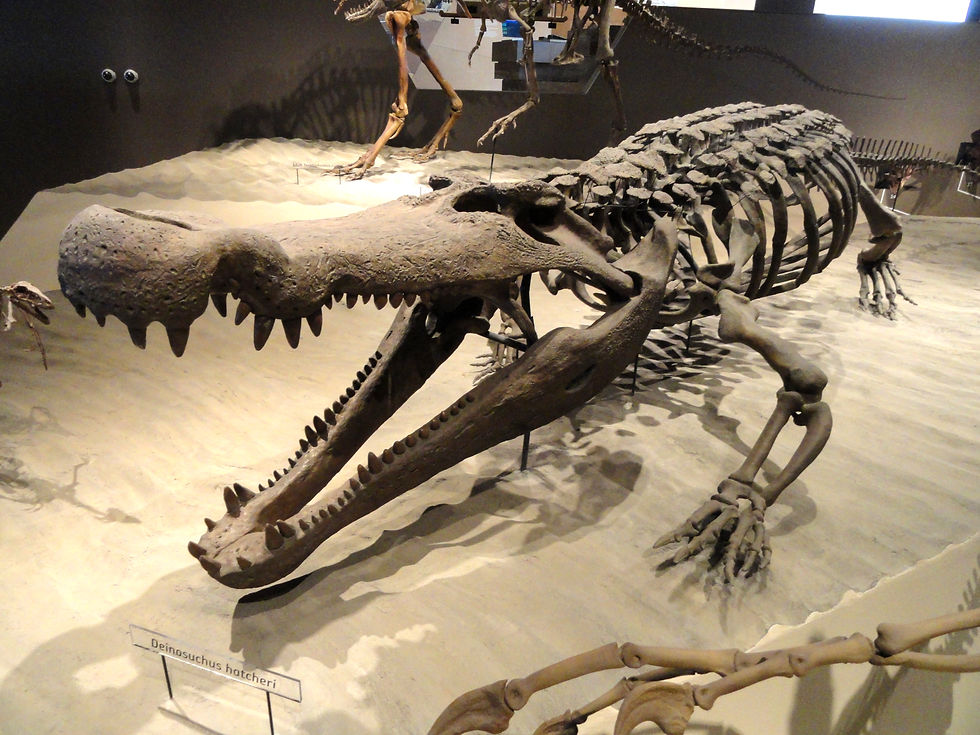Discovering Pliosaurs on the Jurassic Coast of Dorset
- Wayne Munday
- Dec 19, 2023
- 7 min read
Updated: Dec 16, 2024
The Kimmeridge Clay Formation of Britain exposed along the Jurassic Coast at Kimmeridge Bay is amongst the most exciting areas internationally to find marine reptiles dating back to the Jurassic Period.
Following the recent fossil find announcement by The Etches Collection and upcoming BBC television documentary called "Attenborough and the Giant Sea Monster" our blog explores what we know about this fearsome marine reptile called the pliosaur (meaning “more lizard”) and understand why they have a reputation as a formidable ancient sea monster akin to their land based counterpart the king of the meat eating theropod dinosaurs the Tyrannosaurus rex.

Why was Fossil Coast Drinks Co so inspired to brand its Rum Spirit “Kimmeridge”? It’s very simple, the Kimmeridge Bay cliffs and wave cut platform of the Kimmeridge Clay Formation in Dorset dating back 157 million years is a treasure trove of fossil marine reptiles including the pliosaur. It's this story in a bottle that our rum spirit captures.
The Kimmeridge Clay Formation stands as a geological testament to millions of years of Earth's history. Named after the coastal village of Kimmeridge in Dorset where it was first identified. The fossil record of the Kimmeridge Clay Formation tells a fascinating narrative of a once-tropical sea that covered Britain from the Dorset coast to the Yorkshire coast during the Late Jurassic Epoch.
The map below shows the extent of the Jurassic aged Kimmeridge Clay Formation exposed outcrop's and subcrop's and the scope for more fossils finds of large marine reptiles in the future. The Kimmeridge Clay Formation subcrop represents rock that lays directly below an unconformity of younger rock.

The Kimmeridge Clay Formation has a distinctive sequence or rhythms of sedimentary rocks in alternating layers of dark shale, limestone, and clay.
This geological formation preserves a remarkable array of marine fossils, ranging from ammonites, belemnites, fish to marine reptiles such as ichthyosaurs, plesiosaurs and pliosaurs. Many of these fossils can be seen at the wonderful natural history museum in the village of Kimmeridge called The Etches Collection.

In December 2023, The Etches Collection announced to the media that the snout and then the large skull of a huge pliosaur measuring over two-meters had been found in early 2022 by fossil enthusiast Phil Jacobs.
The snout of this pliosaur was first found on the shingle beach of Kimmeridge Bay and later by deploying aerial drones the skull was located.
The pliosaurs skull was excavated by a Team of engineers, professional climbers and palaeontologists organised by The Etches Collection 15 meters up on the cliff.
Google Map showing the location of Kimmeridge Bay and The Etches Collection in Dorset
After months of painstaking preservation by Dr. Steve Etches the large pilosaur skull has been described as one of the most complete specimens ever to be discovered with both its upper and lower jaw intact and it is believed that there “isn't a specimen anywhere else to match it”, says Dr. Etches. It is also believed to be potentially a new species.
In April 2022 the Team at Fossil Coast Drinks Co had the privilege to meet and interview Dr Steve Etches at The Etches Collection for the launch of the Kimmeridge Rum Spirit. What may be surprising to know is that Steve was until only a few years ago a plumbing and heating engineer.
His culturally and scientifically significant fossil collection has been collected over several decades and was until 2016 housed in his garage.

The Etches Collection and Steve’s donation of his entire fossil collection is now housed in a modern building in Kimmeridge and after receiving Heritage Lottery Funding and the support of the local community. Part of this donation included a pliosaur jaw that he had previously discovered in 1982.
A key walkaway from our interview at the time was that he is a artisan with a mindset, commitment and has the much needed patience and skills to spend hours, weeks and months preparing, cleaning and presenting fossil specimens.
In his words, “the priority is always placed on the specimens”. This giant pliosaur skull is a rare opportunity for palaeontologists to learn more about this extraordinary predator and it could not be in better hands. This pliosaur skull will be going on display at The Etches Collection in 2024.
The story of this exciting fossil find has been made into a documentary by the BBC Studios Natural History Unit and Sir David Attenborough called "Attenborough and the Giant Sea Monster" and will first air to television on BBC One 8pm on New Years Day 2024.
The new Kimmeridge Bay pliosaur is not the only one on display along the Jurassic Coast or in the South West of England. A pliosaur skull has been on display for a number of years at the Dorset Museum in Dorchester as part of its Natural Dorset Collection.
This pliosaur was found in 2003 by fossil enthusiast Kevin Sheehan, a retired cafe owner from Osmington, near Weymouth following a landslide on Weymouth Bay. Known colloquially as the “Weymouth Bay Pliosaur” and later named in his honour of Mr Sheehan as Pliosaurus kevani. This pliosaur took over five years to recover from the area of the landslide and a further 18 months of preservation.

The Bristol Museum and Art Gallery has an an eight metre long Pliosaur called “Doris” or Pliosaurus carpenteri found in Westbury, Wiltshire in 1994. Outside of the South West the partial remains of a pliosaur called "The Scunthorpe Pliosaur" was discovered in a North Lincolnshire quarry in October 2017 by Darren Withers during a Stamford and District Geological Society field trip to a quarry and Lower Kimmeridge Clay. This pilosaur is on display at the North Lincolnshire Museum in Scunthorpe.
In 1987 over 80 large fossil bone fragments (no skull) of the “Watermead Pliosaur” was discovered by local geologist Michael Oates during the construction of the new housing development in Watermead north of Aylesbury on Kimmeridge Clay. Based on the bone fragments of this 152 million-year-old pliosaur it was estimated to measure up to 7.5 meters.
Very recently several large cervical vertebrae of a Jurassic Period pliosaur were found in the Kimmeridge Clay Formation near Abingdon in Oxfordshire. Analysis of these fossil remains suggest that this pliosaur may have had a total body length of between 9.8 and 14.4 meters.
Over the years there have been a number of isoloated fossil pliosaur bones excavated from the Oxford Clay and Kimmeridge Clay Formation of southern and eastern England. Some of these fragments have suggested the potential for considerably larger pliosaurs.
The pliosaur was an ancient apex predator that could measure over 12 meters in length, weighing many tonnes and had a bite force calculated at over 33,000 newtons. By comparison to animals alive today only the saltwater crocodile (Crocodylus porosus) commonly found off the coasts of northern Australia, and the islands of New Guinea and Indonesia has today the strongest known bite force at only 16,500 newtons.

The pliosaurs were designed for stealth and speed allowing them to surprise their prey and with their powerful jaws go straight for the kill by brutally puncturing and tearing at the flesh of thier quarry with their rows of over 130 razor-sharp teeth.
The pliosaurs hunted plesiosaurs, ichthyosaurs and other large prey across the Earth’s seas and oceans and within this marine ecosystem the pliosaurs was at the top of the food chain without any natural predators of its own including the longer mosasaur. With large fang like teeth they had no need to chew their food.
During the Mesozoic Era known as the “Age of Reptiles” spanning between 252 – 66 million years ago and including the Triassic, Jurassic and Cretaceous Periods there were five main marine reptile groups that lived in the oceans and seas. Among these groups were the ichthyosaurs, thalattosuchians, mosasaurs, sea turtles and plesiosaurs.

The long-necked plesiosaur meaning “near lizard” of which English palaeontologist William Buckland (1784- 1856) from Axminster and colleague to Mary Anning described in the 1820's as “a serpent threaded through the body of a turtle”. Each marine reptile group evolved very differently but shared similar features in having paddle like limbs and had tails designed to generate propulsion as they swam in the seas and oceans.
The pliosaurs belong to the order of marine reptiles known as the Sauropterygians (meaning "lizard flippers") and generally grew to over 4 meters in length. The earliest sauropterygians in the fossil record are known as nothosaurs that first appeared in the Triassic Period. The nothosaurs were small reptiles with legs rather than paddles and lived on both the land and in aquatic ecosystems.
Sauropterygians would evolve to include the pistosaurs (meaning “credible lizard”) and the long neck plesiosaurs (meaning 'close-to lizard'). These marine reptiles all adapted to life in water rather than land. Pliosaurs or Pliosauromorphs were marine sauropterygian reptiles believed to have evolved from the plesiosaurs though the fossil record of the evolution of gigantic pliosaurs is still incomplete.
The pliosaur is characterised by its massive skull, shorter neck, wide throat, barrel-like body with four large wing-like paddles tapering to a blunt point, and a short, tapered tail.

The pliosaurs swam the oceans and seas for over 80 million years from the Middle Jurassic until the Late Cretaceous. The largest of the pliosaurs is believed to have been the group known as the Thalassophonea (meaning "sea murderer").

This group of pliosaurs includes the giant Lorrainosaurus keileni found in the former region of Lorraine (now part of Grand Est) in northeastern France and Kronosaurus queenslandicus from the Early Cretaceous of Queensland.
In 1977, “El Fósil” or "The Fossil" a 7 meter pliosaur called Monquirasaurus boyacensis was found in the Paja Formation near the Villa de Leyva region of Boyacá in the Eastern Cordillera of Colombia.
These specimens are are on display at the Musée national d’histoire naturelle de Luxembourg, Australian Museum in Sydney and El Centro de Investigaciones Paleontológicas (CIP) in Villa de Leyva, Boyacá, Colombia.







